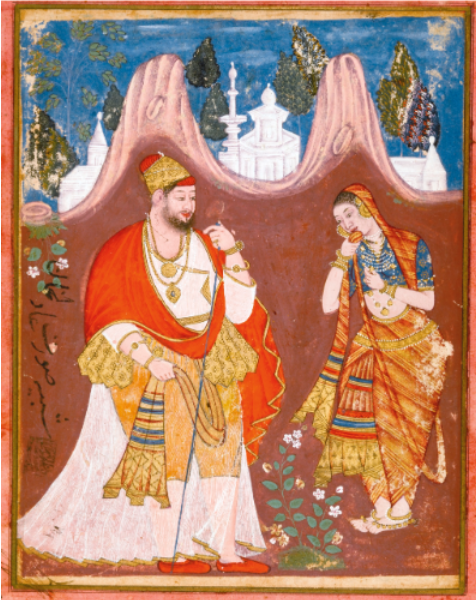This is a painting of the Bijapuri sultan Adil Shah dated to between 1590-1605, complete with inscription by Jahangir, the Mughal emperor, that attests to the likeness: shabihi surat Adilkhan. The painter himself is nameless, but he is considered among the finest artists from the Deccan, and it has been established that he was responsible for nearly half the illustrations in the Pem Nem manuscript, one of the loveliest (and surely the only complete) books of Sufi couplets extant from the medieval period.
Adil Shah had been forced to marry off his daughter to a son of Akbar, following the Mughal conquest of the neighbouring sultanate of Ahmadnagar, and along with the marriage train went hundreds of manuscripts, the Pem Nem among them. Expectedly, you won't find the Pem Nem in India - rather, it's in the British Library.
There are thirty-four illustrations in the Pem Nem, mostly of ink and watercolour and gold and silver, made by three different artists. These paintings had been done on pieces of paper that were then pasted onto the sheets of the manuscript. It's not entirely clear if these artworks were made at the same time as the manuscript was written.
The author of the book was Hasan Manju Khalji. Interestingly, no other books by him are known. The calligraphy is lovely and clear, but as he wrote masnavi couplets in a Deccani Urdu that contains admixtures from Marathi and local dialect, it is difficult to understand today. The text is a narrative poem in rhyme, describing the Sufi's love of and quest for God.
There is frequent wordplay - shah jal bal bal pal tal mal - monosyllabic words that don't make sense. While these interjections remain obscure, the story is well-understood. A prince named Shah Ji seeks a beloved named Mah Ji; the two had fallen in love with each other when a tortoise shows each of them the other's portrait. It then appears that Mah Ji takes on a yogini's guise to seek her lover, while Shah Ji travels around looking for her. He ends up across the oceans on an island called Sangaldip, which, coincidentally, is ruled by his uncle. He finds Mah Ji as well, but rejects her because for him the real Mah Ji is the image in the portrait, while she is only a reflection. He then takes off to seek the truth. So Mah Ji goes through a period of enduring the agony of love (here the masnavi is combined with the Indian baramasa, songs describing a year of love and pain).
Neither the mysterious tortoise nor the trip across the ocean is illustrated, but Shah Ji's arrival and Mah Ji's baramasa are. There are symbols too - Mah Ji's image appears on Shah Ji's chest, and Mah Ji herself is shown burning up in her love despite an attendant dousing the fires of her passion with water. According to [1], such visual metaphors of longing are exceptional and do not often occur in Indian art.
Eventually Shah Ji returns, the couple get married, and the most lavish illustrations in the book depict the nuptial celebrations.
The overwhelming number of female figures in the illustrations seem to imply that the audience for the book was mainly female as well. The use of the dialect and Deccani Urdu may reinforce this viewpoint as that may have been the vernacular in the Sultan's harem. On the other hand, there was a general emphasis of the feminine in Deccani culture at the time. It is therefore not entirely clear for whom the book was meant.
References
1. Deborah Hutton, "The Pem Nem: A Sixteenth Century Illustrated Romance from Bijapur" in Sultans of the South: Arts of India's Deccan Courts, 1323-1687, (ed.) Navina Najat Haidar, Marika Sardar.


0 comments:
Post a Comment